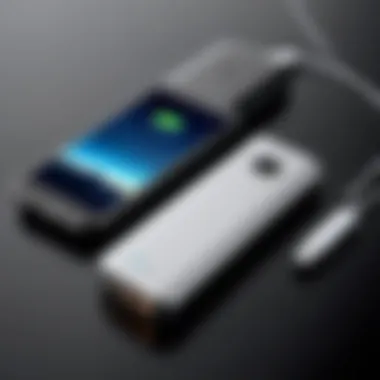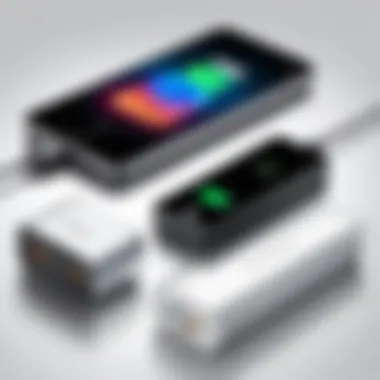An In-Depth Exploration of Leading Power Bank Companies


Intro
The world of portable charging has grown by leaps and bounds over the years. There was a time when a dead phone battery meant a long wait until you could reconnect with the digital world. However, now, thanks to advancements in power bank technology, staying charged is just a matter of having the right equipment on hand. In this article, we delve into the leading companies in the power bank manufacturing arena. Our goal is not just to showcase the products available but also to shed light on the strategies these companies employ to maintain their edge in a fiercely competitive market.
As power bank usage has surged, so have the expectations from consumers. IT professionals and tech enthusiasts are on the hunt for devices that are not only efficient but also innovative and sustainable. With that in mind, we will explore essential performance metrics, usability, user experience, and other aspects that make these companies stand out. Key players in the industry are increasingly focusing on consumer feedback and sustainability initiatives, acknowledging that the landscape is constantly evolving, marked by amazing growth and change.
To get a clearer picture, we will start with an examination of Performance Metrics that sets apart the elite from the mediocre in this vibrant market.
Foreword to Power Banks
As technology advances and our reliance on mobile devices grows, portable charging solutions have become not just a convenience, but a necessity. With longer work hours and a fast-paced lifestyle, the need to stay connected often takes precedence. This is where power banks come into play, embodying the essence of modern-day utility. They allow users to carry a piece of their energy source in their pockets or bags. In this section, we will delve into the nuances of what power banks are, how they function, and why they have become an integral part of our daily lives.
Understanding Power Bank Technology
Power banks primarily function as external battery packs, providing a convenient way to recharge devices without being tethered to a wall socket. The heart of a power bank lies in its battery type, typically lithium-ion or lithium-polymer. The capacity, often measured in milliampere-hours (mAh), indicates how much charge the power bank can hold and therefore how many times it can recharge your devices.
Here are some pivotal aspects of power bank technology:
- Battery Capacity: A higher mAh usually means more charges; for instance, a 10,000 mAh power bank can charge a typical smartphone about two to three times.
- Input and Output Ratings: Pay attention to the input/output specifications. Fast charging technology, such as Qualcomm Quick Charge or USB Power Delivery, allows rapid replenishment of the power bank itself and quicker charging of your devices.
- Design Features: Many current power banks come equipped with features like multiple outputs, built-in cables, and LED indicators for remaining power. All these aspects reflect the growing market's emphasis on user-friendly designs.
Importance of Portable Charging Solutions
Portable charging is not a mere trend but a fundamental evolution in how we use and interact with technology. Gone are the days when we were reliant on wall outlets or hunting for charging stations.
The significance of easy-to-carry charging solutions can be summed up in several clear points:
- Mobility: Whether you're on a business trip, attending a festival, or simply commuting, having a power bank ensures that you are never left stranded with a dead phone — which can be a lifeline for navigation, communication, and social connection.
- Emergency Preparedness: In emergencies, connectivity can be vital. A fully charged power bank can be a game changer during outages or unexpected situations.
- Versatility: Power banks aren't just for phones anymore. They cater to a broad array of devices, including tablets, cameras, and even laptops, making them a versatile tool in anyone’s tech arsenal.
"In an age where every second counts, staying powered up isn't just a luxury; it's an essential part of daily life."
Thus, understanding what power banks are and how they work sets the foundation for appreciating the full spectrum of options available in today's competitive landscape. As we progress through this article, we will assess the critical criteria for evaluating power banks, spotlight the heavyweight contenders in the market, and look to the future of this evolving technology.
Criteria for Evaluating Power Banks
When it comes to selecting a power bank, it's not just about picking the flashiest or the cheapest option. There are critical elements that need thorough consideration. This section lays out the criteria that elevate a simple portable charger into a must-have tool for tech enthusiasts and IT professionals alike.
Capacity and Efficiency Ratings
Capacity is measured in milliampere-hours (mAh), indicating how much energy a power bank can store. A higher mAh rating sometimes sparks excitement, but it's essential to understand that capacity alone doesn't paint the full picture of performance. You may find a power bank rated at 20,000 mAh, yet if its efficiency rate is underwhelming—say around 70%—users might see far less usable energy.
- Usable Capacity:
- Real-World Usability:
- It's important to factor in how much of that stored capacity can be actually utilized to charge your devices.
- A device with 10,000 mAh may only transfer 7,000 mAh after conversion losses, leading to annoyingly frequent replenishments.
- Assess how many times the power bank can charge your devices. For instance, does a 20,000 mAh power bank offer enough juice to charge a smartphone twice or more depending on your phone's battery size?
Understanding these nuances helps ensure that consumers make informed choices based on how they'll actually use these devices in their daily routines.
Charging Speed and Technology


In this fast-paced world, who wants a slow charge? Power banks now come loaded with technology, including Quick Charge, Power Delivery, and variable outputs, which all enhance charging speed.
- Fast Charging Technology:
- Wattage Matters:
- Auto Detect Features:
- Quick Charge 3.0 and 4.0 are two of the industry standards that many modern power banks now boast. Users can boost their devices quickly, fetching back a few hours of usage in mere minutes.
- Power banks can offer different wattages for varying devices. A higher wattage doesn't just equate to speed but also raises the potential for multi-device charging capabilities.
- Smart charging features may determine compatibility with devices to adjust output accordingly. This prevents damaging more delicate devices by delivering too much power, thus ensuring reliability along with speed.
Design and Portability
Next up is how these power banks fit into your lifestyle. A practical power bank should blend functionality with portability, ensuring ease of transport without sacrificing performance.
- Size and Weight:
- Build Quality:
- Aesthetic Appeal:
- Many users prefer compact designs that can easily fit in their bag or pocket, but make sure it doesn’t skimp on capacity.
- There are also larger models that offer more power but perhaps weigh a bit more, and assessing your personal requirements can help reach the right balance.
- A rugged design might be more appealing to those who travel or work in harsher environments. Ensure features such as splash resistance or durable materials that use shockproof designs to increase longevity.
- The design isn’t just for it to look pretty. A well-designed power bank would often have ergonomics to ensure comfortable handling during use.
All these factors feed into user satisfaction, as power banks are no longer just utility devices but extensions of one's personal style and functionality.
Safety Features and Reliability
Trustworthiness can’t be overlooked in any tech gadget. A power bank’s safety can often determine whether it becomes a staple in your tech arsenal or sits at the back of a drawer gathering dust.
- Protection Mechanisms:
- Look for features, like over-charge protection, temperature control, and short circuit prevention, which safeguard both the power bank and connected devices.
"Choosing a power bank without the right safety features is like driving a car without airbags. Take a risk you can avoid."
- Warranty and Support:
- Real-World Testing:
- A good warranty period signals a manufacturer’s confidence in their product. Reliable tech should come with solid customer support, ensuring you can resolve any issues swiftly.
- Reviews and field testing reports can provide valuable insights into how a product performs over time. Knowing other users' experiences can help gauge reliability.
Ultimately, evaluating these criteria won't just help you choose a power bank but will allow you to select one that stands the test of time, enhances your tech experience, and delivers on safety, functionality, and convenience.
Leading Power Bank Companies Overview
The landscape of portable charging solutions has evolved dramatically in the past few years, and understanding the leading power bank manufacturers is fundamental for making informed choices. This section delves into the giants of the industry—Anker, RAVPower, Mophie, Zendure, and Xiaomi. By looking closely at these companies, we can appreciate their contributions to technology and consumer convenience.
Anker: Innovation and Versatility
Product Range Analysis
Anker stands tall in the world of portable power banks, known for its vast product range which caters to diverse user needs. The hallmark of Anker's success lies in their innovation and versatility. Anker's offerings include everything from compact models suitable for everyday carry to high-capacity power stations capable of charging multiple devices at once. This variety allows consumers to pick options tailored to their preferences—be it a slim charger for an evening out or a robust option for a weekend camping trip. Additionally, the PowerIQ and VoltageBoost technologies enhance charging efficiency. However, some customers note that while Anker's prices are generally fair, certain models do veer toward the high end without any significant added benefits.


User Feedback and Reputation
Consumer feedback paints a positive picture for Anker, often highlighted by its reputation for reliability. Many users appreciate how their products have stood the test of time and performance, noting the durability of Anker power banks. Reviews consistently praise the product’s battery longevity and charging speed, making them a sought-after choice in the marketplace. Yet, as with all brands, there are a few voices in the crowd who raise concerns about the customer service experience, contending that it could use some improvement.
RAVPower: Power and Performance
Feature Highlights
RAVPower shines with its commitment to performance-focused features that cater to tech-savvy users. Their products boast high wattage output, efficient charging times, and multiple USB ports for simultaneous device charging. A standout trait is their ability to deliver fast charging capabilities, which aligns well with the increasing demand for rapid energy replenishment. Many users value the specific targeting of features like smart charging technology, allowing devices to receive optimal charging speeds. However, some users point out that while RAVPower offers impressive performance, their design might not always be the most aesthetic.
Market Reception
The market has received RAVPower favorably, as evident by its strong ratings and loyal customer base. Users tend to appreciate the balance of performance and price RAVPower manages to strike. The brand is often seen as a solid alternative to larger names like Anker. Notably, RAVPower's willingness to offer generous warranties appears to reinforce consumer trust, although a minority of customers voice concerns over the longevity of some specific models, suggesting that quality control could be more robust.
Mophie: Premium Design and Functionality
Product Aesthetics
Mophie distinguishes itself through its focus on stylish, premium designs that appeal to a design-conscious crowd. Their offerings are not only visually appealing but also feature high-quality materials, making them a favorite among power users who appreciate aesthetics without sacrificing functionality. Users often feel that Mophie's power banks serve not just as utility items but also as fashion accessories, seamlessly integrating into their daily lives. However, it must be noted that this premium quality comes with a price, often putting Mophie at a higher price point compared to its competitors.
Target Audience Insights
Mophie's target demographic encompasses fashion-forward individuals who prioritize style alongside function. This strategic positioning allows Mophie to carve a niche for itself among consumers willing to pay extra for brand prestige and aesthetic appeal. Many users laud the combination of functionality and usability in Mophie's products, while some express that the high cost can deter potential buyers, making it less accessible for budget-conscious consumers.
Zendure: Durability and Efficiency
Unique Selling Propositions
Zendure's unique selling proposition lies in its reputation for exceptional durability and efficiency. Constructed to withstand tough conditions, their power banks feature a robust design that can handle the rigors of travel and outdoor use. The A-Series has received accolades for its ability to perform even in challenging environments, ensuring that users won't be left powerless. Yet, there are discussions around whether Zendure's heavy-duty construction might come with a weight penalty, making some models bulkier than others.
Customer Base Analysis
Zendure appeals to a niche, outdoor-loving demographic that values reliability, making it popular among travelers and adventure enthusiasts. This focus on durability has forged a devoted customer base who appreciates longevity over aesthetics, often reporting satisfaction with the performance in extreme conditions. A downside is that this focus on robustness may inadvertently alienate more casual users who might find the brand's offerings excessive for day-to-day needs.
Xiaomi: Affordable Innovation
Product Offerings
Xiaomi embraces a philosophy of affordability without compromising innovation. Their lineup includes a variety of power banks that are accessible to a wider audience, thanks to competitive pricing. Xiaomi's foray into power banks sees them integrating smart features typically reserved for more expensive products, like high-capacity options and fast charging technology. Nonetheless, there's a consensus that while Xiaomi offers great value, the occasional absence of customer support and warranty options can be a drawback.
Market Impact
Xiaomi’s entry has notably affected the power bank market, driving prices down across the board. They’ve carved out a substantial market share and have often been perceived as a disruptor, forcing competitors to reconsider their pricing strategies. Their approach has led some established brands to introduce more budget-friendly lines, illustrating Xiaomi's influence. Still, certain customers express concern about the consistency of build quality between models, noting that lower prices can sometimes correlate with reduced longevity.
Emerging Trends in Power Bank Technology
The power bank market is rapidly evolving, with manufacturers continually pushing the boundaries of technology to cater to the increasing demand for efficient and versatile charging solutions. In today’s world, where gadgets are an integral part of daily life, understanding these emerging trends in power bank technology is crucial. Not only do these advancements improve user experience, they also reflect wider shifts in consumer expectations regarding energy consumption and sustainability. This section explores significant trends shaping the industry, including fast charging innovations, multi-device capabilities, and the integration of renewable energy sources.
Fast Charging Innovations
Fast charging has become one of the most anticipated features in power banks. The expectation is simple: not spending hours waiting for devices to charge. Companies have developed technologies like Quick Charge and Power Delivery which enable devices to charge significantly quicker than standard rates. For instance, recent power banks can deliver up to 100W of power, effectively charging laptops alongside smartphones, something unthinkable a few years back.


This trend isn’t just about speed; it’s also about efficiency. Fast charging minimizes energy loss, which is a big plus for eco-conscious users. Furthermore, the advent of USB-C connectors has streamlined charging processes for numerous devices, making it more user-friendly.
"The essence of fast charging is not just about how quickly a device fills up, but also about ensuring safety and longevity for the device’s battery."
Multi-Device Charging Capabilities
With the rise of a gadget-centric lifestyle, multi-device charging capabilities have become essential. Users often carry multiple devices such as smartphones, tablets, and wearables. The need for a single charging solution is more pressing than ever. Power banks that feature multiple output ports—ranging from USB-A to USB-C—allow users to charge several devices simultaneously.
Some innovative players have also introduced wireless charging options to the mix, enabling effortless interactions without fumbling with wires. This flexibility caters to a broader range of consumers, from tech novices to hardcore enthusiasts. For example, power banks equipped with Qi technology facilitate charging for various devices without hassle, appealing to those who prioritize convenience.
Integration with Renewable Energy
The current climate crisis has catalyzed interest in sustainable energy solutions. Power banks that integrate renewable energy—especially solar charging capabilities—are gaining traction. These devices not only allow for charging on-the-go, they empower users to utilize an eco-friendly energy source.
Equipping power banks with solar panels signifies a step toward reducing dependency on traditional energy. Imagine hiking with a power bank that collects energy from the sun, providing sustainable charging capabilities right there amidst nature. This unique selling proposition is helping brands differentiate themselves in a crowded market. As consumers grow increasingly aware of their carbon footprint, the shift towards greener technologies will likely continue.
Customer Perspectives and Market Insights
Understanding customer perspectives and market insights in the realm of power banks holds immense significance in shaping the landscape of the industry. As technology enthusiasts and IT professionals delve deeper into specifics, the feedback and preferences of end users illuminate the path forward for innovation and product refinement. Companies that listen closely to their customers' needs not only enhance their product offerings but also build lasting relationships that foster brand loyalty. By integrating real-world experiences into their development processes, manufacturers can tune in to what actually matters to consumers.
Analyzing Consumer Preferences
Analyzing consumer preferences is like peeling away the layers of an onion to reveal what truly lies at the core of a customer's decision-making process when it comes to purchasing power banks. Users often prioritize factors such as capacity, charging speed, design, and portabilty, which can vary widely depending on individual lifestyles and tech needs. For instance:
- Capacity: Power bank capacity, measured in milliamp hours (mAh), often becomes a key factor. Heavy users, who rely on multiple device usage (smartphones, tablets, wearables), generally seek higher-capacity units to avoid running out of juice.
- Charging Speed: Rapid charging technology plays a pivotal role too. Many consumers are tempted by power banks that can deliver a quick top-up. Quick Charge and Power Delivery are names that often bubble to the surface.
- Design: The aesthetics can’t be ignored. Sleek designs, lightweight frames, and compactness appeal to the masses, especially among a younger demographic.
Further, paying attention to consumer feedback provides businesses with valuable insights into enhancing their product lines. Social media platforms, such as Reddit or Facebook, facilitate dialogue where customers share their experiences. Engaging with these conversations informs manufacturers about potential improvements and emerging trends.
Sustainability and Ethical Considerations
In recent times, sustainability and ethical considerations have transitioned from fringe concerns to mainstream priorities for both consumers and manufacturers. When it comes to power banks, many customers are now asking: "How environmentally friendly is this product?" This reflects a growing trend in conscious consumption. Key points here include:
- Material Sourcing: Consumers are increasingly inclined to choose brands that use recyclable materials or sustainably sourced components. People want to make sure their purchases align with their values—nobody wants to feel guilty about their gadgets contributing to e-waste.
- Lifecycle: The product’s entire lifecycle, from production to disposal, influences purchasing decisions. Brands that provide clear information on recycling should find favor with eco-conscious buyers.
- Transparency: Ethical business practices aren't just a luxury anymore; they are expected. Consumers tend to gravitate towards companies that are open about labor practices and environmental impact.
In a market where choices abound, making ethical choices can create a competitive advantage that resonates with modern values.
Epilogue: The Future of Power Bank Companies
The landscape of power banks continues to evolve rapidly, impacted by technological advancements and shifting consumer demands. The significance of this topic is paramount, not just for industry veterans but also for those who rely on portable energy. Understanding these developments can be quite beneficial for aligning purchasing decisions with future innovations.
Predictions for Market Evolution
The next few years hold exciting prospects for the power bank market. Several trends are already shaping the future:
- Increased Capacity with Compact Design: Manufacturers are likely to enhance energy density, allowing for more power in smaller packages. This trend caters to users seeking portability without sacrificing battery capacity.
- Wireless Charging Dominance: With advancements in wireless technology, power banks that support Qi charging are expected to gain traction. This convenience may become a standard feature for many brands, appealing to users seeking a cable-free experience.
- Smart Power Management: Future power banks may adopt AI to optimize charging times and speeds. This intelligent capacity can distinguish device needs and adjust accordingly, extending the lifespan of both the power bank and the electronic devices being charged.
- Sustainability Focus: As consumers grow more aware of environmental issues, manufacturers will probably increase the use of eco-friendly materials in production and design. This trend will not only attract a conscientious customer base but also demonstrate a brand’s commitment to sustainability.
These predictions highlight a shift towards smarter, more efficient products that align with contemporary consumer expectations and an urgent need for eco-responsibility.
Final Thoughts on Industry Leaders
Leading companies in the power bank sector have laid a solid groundwork for the future through their relentless pursuit of innovation. They stand at the forefront of market trends and consumer needs. Here are a couple of reflections:
- Anker has consistently been a bright spot in the market, known for its focus on reliability and customer satisfaction. Their ability to adapt to trends indicates they’ll likely remain a dominant player.
- Xiaomi impresses with affordability while not skimping on features. This strategy of providing value ensures its place as a consumer favorite, particularly in regions looking for cost-effective solutions.
Many other players also contribute significantly to the landscape. Brands like RAVPower and Mophie bring unique strengths, catering to diverse market segments. Observing how these companies position themselves in response to market trends will be crucial for industry-followers.
In summary, the future for power bank companies is promising yet challenging. Staying relevant will require a focus on innovation, quality, and sustainability. The industry must also be responsive to the evolving tastes of tech-savvy consumers who expect more from their portable charging solutions.



